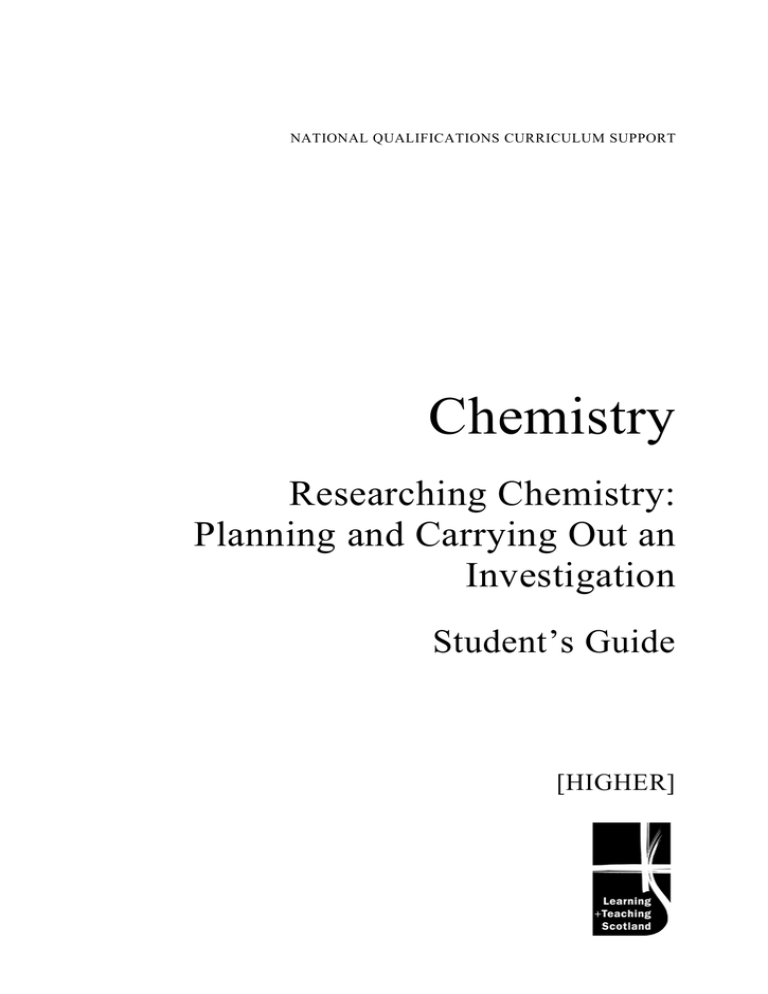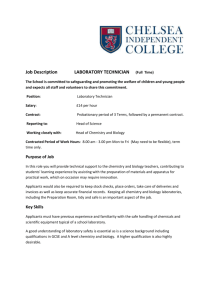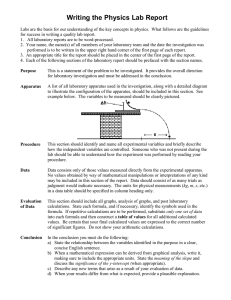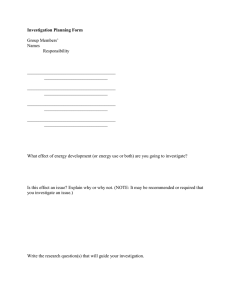Chemistry Researching Chemistry: Planning and Carrying Out an Investigation
advertisement

NATIONAL QUALIFICATIONS CURRICULUM SUPPORT Chemistry Researching Chemistry: Planning and Carrying Out an Investigation Student’s Guide [HIGHER] The Scottish Qualifications Authority regularly reviews the arrangements for National Qualifications. Users of all NQ support materials, whether published by Learning and Teaching Scotland or others, are reminded that it is their responsibility to check that the support materials correspond to the requirements of the current arrangements. Acknowledgement Learning and Teaching Scotland gratefully acknowledges this contribution to the National Qualifications support programme for Chemistry. © Learning and Teaching Scotland 2011 This resource may be reproduced in whole or in part for educational purposes by educational establishments in Scotland provided that no profit accrues at any stage. 2 PLANNING AND CARRYING OUT AN INVESTIGATION (H, CHEMISTRY) © Learning and Teaching Scotland 2011 Contents Introduction for teachers 4 Planning a scientific investigation 5 Identifying the key stages 6 Assessing the safety risk 8 Identifying practical techniques and equipment 11 The importance of planning ahead 13 Planning checklist 15 Solutions 16 PLANNING AND CARRYING OUT AN INVESTIGATION (H, CHEMISTRY) © Learning and Teaching Scotland 2011 3 STUDENT’S GUIDE Introduction for teachers Outcome 2 of the Researching Chemistry unit of the revised Higher Chemistry requires students to demonstrate that they can ‘effectively plan and carry out investigative practical work relating to a topical issue in chemistry’. Despite the skill of effective planning being essential for life, learning and work, there is very little in the way of formal resources to support teachers and students with the development of this skill within an investigative scientific context. The purpose of this resource is to allow students to consider the essential stages involved in planning a scientific investigation at Higher Chemistry level, and then to actively develop their own planning skills by completion of a number of focused exercises and activities set in a researching chemistry context. It is hoped that completion of the range of tasks within this resource prior to undertaking independent investigative work will allow students to have an increased appreciation of the importance of planning in advance before carrying out practical activities within a science laboratory. Students could work through this resource independently or as part of a pair or a small group, although regular opportunities for whole class discussion and reflection are recommended throughout the activity. Answers to questions and other activities are contained at the end of the resource. 4 PLANNING AND CARRYING OUT AN INVESTIGATION (H, CHEMISTRY) © Learning and Teaching Scotland 2011 STUDENT’S GUIDE Student’s guide Planning a scientific investigation Planning is an essential skill for life, learning and work. Effective planning enables priorities to be dealt with in a controlled manner instead of simply reacting to things as they come along. Planning ahead enables good organisation and saves time, effort and resources. The ability to plan effectively will also be crucial when undertaking your scientific investigation during the Researching Chemistry unit of Higher Chemistry. Indeed, in order to achieve Outcome 2 of this unit you must show that you can ‘effectively plan and carry out investigative practical work relating to a topical issue in chemistry’. Planning a scientific investigation can be a daunting prospect, however. Where should you start? What are the planning priorities? Which technique should you use? What apparatus and chemicals will be required? How can you ensure the safety of yourself and others during the practical aspects of the investigation? This resource pack will help you to develop the skills of effectively planning a scientific investigation at Higher Chemistry level. By completing the exercises and activities within the pack, you will develop the skills and confidence to enable you to: • think of an investigation in terms of a number of key stages • identify the key stages in planning and carrying out a scientific investigation • select the appropriate practical technique(s) and apparatus for a particular procedure • recognise that there are always significant safety risks when carrying out scientific procedures that must be taken into account in the planning stages • appreciate the importance of planning before starting the experiment. PLANNING AND CARRYING OUT AN INVESTIGATION (H, CHEMISTRY) © Learning and Teaching Scotland 2011 5 STUDENT’S GUIDE Identifying the key stages What are the key stages involved in effectively planning and carrying out a scientific investigation? Let’s try to work them out by first identifying the key stages in a more familiar procedure – making a cup of tea! Exercise 1: Planning and carrying out an everyday procedure You can probably make a cup of tea without really thinking about the stages involved. However, imagine you need to write a list of instructions for someone who has never made a cup of tea before. (a) Write down a list of the key stages involved in making a cup of tea. You have 1 minute to complete this task! Compare your list with those of the others in your group. Have you all written the same steps? Have any important steps been missed out? Are some steps not always required? What does this tell you about the importance of planning ahead? 6 PLANNING AND CARRYING OUT AN INVESTIGATION (H, CHEMISTRY) © Learning and Teaching Scotland 2011 STUDENT’S GUIDE (b) The table below shows the stages involved in making a cup of tea. Number these stages in the order in which they should be carried out to successfully make a cup of tea. Decide to have a cup of tea Put water in kettle Turn on tap Get out the sugar Stir with teaspoon Switch on kettle to boil water Get out the cup Get out the teabag Get out the teaspoon Add sugar Get out the milk Turn off tap Add boiling water to cup Leave for 2 minutes Wash dishes Put teabag in cup Tidy up Add milk Drink tea Remove teabag with teaspoon Put teabag in bin Put teaspoon in cup Compare your list with those of others in your group and discuss the questions below. Are there any variations in the order in which you would carry out the stages? Are some of the stages not required in every case? Would the order be dependent on the location in which you are making the cup of tea? Which method makes the most effective use of time and resources? Could you group any of the stages together to save time? Why is it important to plan ahead when carrying out a complex procedure? PLANNING AND CARRYING OUT AN INVESTIGATION (H, CHEMISTRY) © Learning and Teaching Scotland 2011 7 STUDENT’S GUIDE An everyday procedure such as making a cup of tea can be summarised as a series of stages. The more complicated process of planning and carrying out a scientific investigation can also be broken down into a similar series of stages. Exercise 2: Planning and carrying out an investigation The stages involved in making a cup of tea could be grouped into the broad categories listed in the table below. Fill in the blanks to show the equivalent categories involved when planning and carrying out of a scientific investigation. Making a cup of tea Scientific investigation Decide to have a cup of tea Source ingredients Collect kitchen equipment Make tea Drink tea Tidy up Assessing the safety risk A crucially important part of the planning process for any everyday procedure involves assessing how to safely carry out the procedures involved. For example, when making a cup of tea it is important to take precautions to ensure that water and electricity are kept apart, and to avoid spilling boiling water on your skin. Each chemical you plan to use in your investigation will have an associated risk. This risk will be described on the hazard warning label on the chemical. The use of hazard symbols is regulated by law, and the symbols used are internationally agreed. 8 PLANNING AND CARRYING OUT AN INVESTIGATION (H, CHEMISTRY) © Learning and Teaching Scotland 2011 STUDENT’S GUIDE Exercise 3: Understanding hazard warning labels The table below contains a number of hazard warning labels. Use the internet or look up a chemical catalogue to help you identify which hazard is represented by each warning label. Warning label Hazard Note: Some chemicals are too hazardous to be used in schools, therefore not all of these warning labels will be found in your chemistry laboratory! PLANNING AND CARRYING OUT AN INVESTIGATION (H, CHEMISTRY) © Learning and Teaching Scotland 2011 9 STUDENT’S GUIDE Once the hazards associated with a particular chemical have been identified, a risk assessment must be carried out. The risk assessment allows appropriate precautions to be put in place to allow the chemical to be handled safely. Note: It is appropriate to wear safety glasses at all times when handling chemicals. Exercise 4: Risk assessment Complete the table below to identify the precautions that should be taken in order to safely carry out each laboratory situation. Laboratory situation Precaution(s) required Pouring a corrosive chemical Weighing out a toxic chemical Heating a reaction mixture involving a flammable reactant A chemical reaction for which one of the products is a toxic gas Disposal of chemical waste which is harmful to the environment Note: The safety precautions required for each experiment and investigation will be different. If you are in any doubt whatsoever about the safety procedures required for your investigation, make sure you speak to your teacher before you start practical work! 10 PLANNING AND CARRYING OUT AN INVESTIGATION (H, CHEMISTRY) © Learning and Teaching Scotland 2011 STUDENT’S GUIDE Identifying practical techniques and equipment A crucial stage in planning a scientific investigation is to identify the most appropriate practical technique to allow you to safely carry out your experiment. Exercise 5: Common laboratory techniques Match up each laboratory technique in the table below to its most appropriate use. Technique Use Filtration Weighing out chemicals Heating using a water bath Determining the concentration of a solution Distillation Heating an aqueous solution rapidly to 60°C Use of balance Separating a mixture of liquids Heating using a Bunsen burner Collecting a gas that is insoluble in water Use of a gas syringe to collect a gas Separating a solid from a liquid Titration Heating a flammable liquid to 120°C Collecting a gas over water Maintaining an enzymatic reaction at 37°C Heating using a heating mantle Collecting a water-soluble gas Having identified the most appropriate technique for a particular scientific investigation, apparatus must then be selected to allow that technique to be carried out effectively and safely. PLANNING AND CARRYING OUT AN INVESTIGATION (H, CHEMISTRY) © Learning and Teaching Scotland 2011 11 STUDENT’S GUIDE Exercise 6: Identifying appropriate apparatus Name the pieces of apparatus in the table below. Do you know what each one is used for? Apparatus Name Apparatus Name Apparatus Name Apparatus Name 12 PLANNING AND CARRYING OUT AN INVESTIGATION (H, CHEMISTRY) © Learning and Teaching Scotland 2011 STUDENT’S GUIDE The importance of planning ahead Planning ahead is essential for safe and effective practical experimentation in chemistry. For example, some of the stages required to successfully carry out an experimental procedure may be implied, rather than explicitly written in the text. Consider the following procedure for testing solubility: The solubility in water of ammonium sulfate, potassium nitrate, sodium nitrate, calcium phosphate and ammonium phosphate was tested by adding a spatula of each compound to 10 cm 3 of water. The results for each compound were recorded as soluble or insoluble. This procedure could be broken down into simpler stages to assist with planning. For example: 1. 2. 3. 4. 5. 6. Place five test-tubes in a test-tube rack. Pour 10 cm 3 of water from a measuring cylinder into each test-tube. Add a spatulaful of ammonium sulfate to one of the test-tubes. Gently agitate the test-tube to identify whether or not the ammonium sulfate dissolves. Record whether the ammonium sulfate is soluble or insoluble. Repeat steps 3 to 5 for each of the remaining compounds. Exercise 7: Why is planning ahead essential? Answer the questions below in discussion with a partner. 1. Which of the stages in the list of instructions above were not specifically mentioned in the original experimental procedure? 2. What types of issues could arise during practical work if proper planning has not been carried out in advance? PLANNING AND CARRYING OUT AN INVESTIGATION (H, CHEMISTRY) © Learning and Teaching Scotland 2011 13 STUDENT’S GUIDE Exercise 8: Making a detailed plan from an experimental procedure Consider the following procedure for separating salt from rock salt. Five spatulafuls of rock salt and 50 cm 3 of water were added to a beaker and stirred for approximately 5 minutes. The mixture was subsequently filtered, and the filtrate transferred to an evaporating basin. The filtrate was then evaporated almost to dryness using a Bunsen burner. The heat was removed and the salt crystals were left to dry overnight at room temperature. Now break the procedure down into a logical and detailed series of stages. In order to do this, you will have to plan ahead. (You may in particular wish to consider which apparatus and chemicals you will need to collect, and at what point in the procedure it would be most appropriate to collect and assemble them). Answer _______________________________________________________________ _______________________________________________________________ _______________________________________________________________ _______________________________________________________________ _______________________________________________________________ _______________________________________________________________ _______________________________________________________________ _______________________________________________________________ _______________________________________________________________ _______________________________________________________________ _______________________________________________________________ _______________________________________________________________ _______________________________________________________________ _______________________________________________________________ 14 PLANNING AND CARRYING OUT AN INVESTIGATION (H, CHEMISTRY) © Learning and Teaching Scotland 2011 STUDENT’S GUIDE Planning checklist The checklist below will help you to successfully plan and carry out the practical aspects of your Researching Chemistry investigation. √ Checklist Choose a topic Identify the most appropriate technique Plan the stages of the experiment Assess risks and plan to safely overcome these risks* Identify and collect the required chemicals Identify and collect the required apparatus Carry out the experimental procedure to produce and collect results Clean up *Safety considerations must be revisited throughout all planning and practical stages. Good luck with planning and carrying out your Researching Chemistry investigation! PLANNING AND CARRYING OUT AN INVESTIGATION (H, CHEMISTRY) © Learning and Teaching Scotland 2011 15 SOLUTIONS Solutions Exercise 1 (parts a and b) Specimen answer 1. 2. 3. 4. 5. 6. 7. 8. 9. 10. 11. 12. 13. 14. 15. 16. 17. 18. 19. 20. 21. 22. Decide to have a cup of tea Turn on tap Put water in kettle Turn off tap Switch on kettle to boil water Get out the cup Get out the teaspoon Put teaspoon in cup Get out the teabag Put teabag in cup Get out the sugar Add sugar Add boiling water to cup Leave for 2 minutes Get out the milk Add milk Stir with teaspoon Remove teabag with teaspoon Put teabag in bin Drink tea Wash dishes Tidy up Note: There may be more than one way to sensibly carry out this procedure! Some stages may not always be required (for example, not everyone takes milk or sugar in their tea). There can be some flexibility in the order in which some of the stages are carried out (for example, some people may prefer to add the sugar after the milk, others before the milk). The order of collection of equipment may be dependent on its location within the kitchen. However, in general, planning ahead ensures that all the appropriate ingredients and equipment are available, that no key steps are missed out and that the procedure is carried out smoothly and quickly. 16 PLANNING AND CARRYING OUT AN INVESTIGATION (H, CHEMISTRY) © Learning and Teaching Scotland 2011 SOLUTIONS Exercise 2 Making a cup of tea Scientific investigation Decide to have a cup of tea Decide on topic for investigation Source ingredients Collect chemicals required Collect kitchen equipment Collect apparatus Make tea Carry out the procedure Drink tea Collect results Tidy up Put away apparatus and dispose of chemicals safely PLANNING AND CARRYING OUT AN INVESTIGATION (H, CHEMISTRY) © Learning and Teaching Scotland 2011 17 SOLUTIONS Exercise 3 Warning label Meaning Flammable substance Toxic substance Hazardous to the environment Oxidising substance Explosive substance Irritant Harmful Corrosive Radioactive 18 PLANNING AND CARRYING OUT AN INVESTIGATION (H, CHEMISTRY) © Learning and Teaching Scotland 2011 SOLUTIONS Exercise 4 Laboratory situation Precaution(s) required Pouring a corrosive chemical Weighing out a toxic chemical Rubber gloves to protect hands Lab coat to protect clothing Use the chemical on a small scale Rubber gloves to protect hands Carry out in a fume-cupboard Heating a reaction mixture involving a flammable reactant Keep away from naked flames A chemical reaction for which one of the products is a toxic gas Carry-out in a fumehood Disposal of chemical waste which is harmful to the environment Use the chemical on a small scale Disposal in an appropriate waste container Exercise 5 Technique Use Filtration Separating a solid from a liquid Heating using a water bath Maintaining an enzymatic reaction at 37°C Distillation Separating a mixture of liquids Use of balance Weighing out chemicals Heating using a Bunsen burner Heating an aqueous solution rapidly to 60°C Use of a gas syringe to collect a gas Collecting a water-soluble gas Titration Determining the concentration of a solution Collecting a gas over water Collecting a gas which is insoluble in water Heating using a heating mantle Heating a flammable liquid to 120°C PLANNING AND CARRYING OUT AN INVESTIGATION (H, CHEMISTRY) © Learning and Teaching Scotland 2011 19 SOLUTIONS Exercise 6 Apparatus Name Conical flask Burette Dropper pipette Thermometer Measuring cylinder Volumetric flask Evaporating dish Delivery tube Funnel Test-tube Boiling-tube Pipette and safetyfiller Apparatus Name Apparatus Name Apparatus Name 20 PLANNING AND CARRYING OUT AN INVESTIGATION (H, CHEMISTRY) © Learning and Teaching Scotland 2011 SOLUTIONS Exercise 7 1. Steps 1 and 2 are not mentioned explicitly in the written paragraph. 2. Issues due to lack of planning could include running out of chemicals in the middle of the experiment, not having the required apparatus to hand at the appropriate time, working unsafely because inappropriate apparatus has been selected, running out of time to complete practical work, etc. Exercise 8 Specimen answer 1. Measure out five spatulafuls of rock salt into a 100 cm 3 beaker. Measure out 50 cm 3 of water using a measuring cylinder. 2. Add the water to the beaker of rock salt. 3. Stir the mixture for 5 minutes using a glass stirring rod. 4. Fold a filter paper into a cone and put it in a filter funnel. Put the filter funnel into a conical flask. 5. Filter the salt solution through the filter funnel. 6. Pour the filtrate (liquid) from the conical flask into an evaporating basin. 7. Set up a tripod on a heatproof mat and put the evaporating basin onto the tripod. 8. Light a Bunsen burner and place it under the tripod to heat the salt solution in the evaporating basin. Heat the solution until most of the water has gone. 9. Turn off the gas and let the salt dry at room temperature. PLANNING AND CARRYING OUT AN INVESTIGATION (H, CHEMISTRY) © Learning and Teaching Scotland 2011 21




